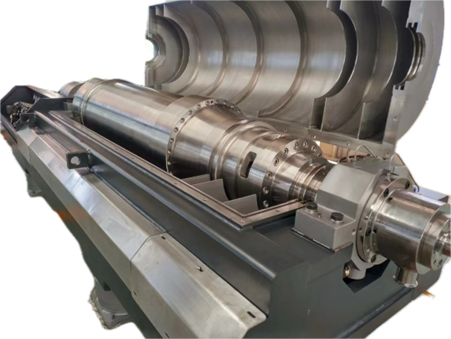3 Phase Decanter Centrifuge
3 Phase Decanter Centrifuge
A three-phase decanter centrifuge is an advanced solid-liquid-liquid separation device that utilizes centrifugal force to separate two immiscible liquids and solid particles from a mixture or slurry. The main components of a three-phase decanter include a rotating bowl, a screw conveyor, a gearbox, a feed tube, and adjustable weir plates.

How It Works:
-
- The mixture is fed into the rotating bowl through the feed tube.
- The high-speed rotation of the bowl generates centrifugal force, causing the heavier solid particles to settle on the bowl’s inner wall, while the two immiscible liquids form concentric inner layers based on their densities.
- The screw conveyor, rotating at a slightly different speed than the bowl, moves the settled solids towards the conical end of the bowl.
- The adjustable weir plate controls the depth of the liquid layers, allowing the separation of the two liquids.
- The solids are discharged through the solids discharge ports, while the two separated liquids flow towards the opposite end of the bowl and are discharged through their respective liquid overflow ports.
Applications:
Three-phase decanters are suitable for various industries and applications, including:
-
- Oil and gas industry: Separating oil, water, and solids from crude oil production streams, such as produced water and drilling mud.
- Food and beverage processing: Separating oil, water, and solids in the production of olive oil, palm oil, and coconut oil.
- Renewable energy: Separating oil, water, and solids in the production of biodiesel and algae-based biofuels.
- Chemical and pharmaceutical industries: Separating two immiscible liquids and solids from reaction mixtures or process streams.
- Environmental remediation: Separating oil, water, and solids in the cleanup of oil spills and contaminated soil.
Three-phase decanters are highly efficient and adaptable to various process conditions, making them a valuable asset in solid-liquid-liquid separation applications across multiple industries.
When it comes to three-phase decanter centrifuges, there are three main configurations designed for specific solid-liquid-liquid separation tasks: separation, classification, and clarification. While all three-phase decanters operate on the same basic principle of using centrifugal force to separate solids and two immiscible liquids, they differ in design and operation to optimize performance for each application.
1. Three-phase separation decanter centrifuges:
Separation decanters are designed to efficiently separate two immiscible liquids and solids from a mixture. Key features include:
-
-
- Adjustable weir plates to control the depth of the liquid layers
- Separate discharge ports for each liquid phase and solids
- Optimized bowl and conveyor designs for effective separation
-
Common applications for separation decanters include produced water treatment in the oil and gas industry, olive oil production, and biodiesel production.
3. Three-phase clarification decanter centrifuges:
Clarification decanters remove small amounts of solids from a mixture of two immiscible liquids, producing highly clarified liquid overflows. Key features include:
-
-
- High bowl speed to generate high centrifugal forces for efficient solids separation
- Shallow pond depths to minimize liquid retention time
- Special feed zone design to reduce turbulence and enhance settling
- Optional baffle plates to improve separation efficiency
-
Clarification decanters are used in applications such as oil/water/solids separation in industrial wastewater treatment and the clarification of oil-based products.
2.Three-phase classification decanter centrifuges:
Classification decanters separate solid particles based on size and/or density while also separating two immiscible liquids. Key features include:
-
-
- Multiple discharge ports for different size/density solid fractions
- Adjustable weir plates to control the liquid layer depths and classification cut points
- Specialty conveyor designs for enhanced solids handling
-
Classification decanters are used in applications such as mineral processing, where solids of different sizes or densities need to be separated along with two liquid phases.
Our three-phase decanter centrifuges can be tailored for separation, classification, or clarification applications by optimizing design parameters such as bowl length, bowl speed, cone angle, weir plate configuration, and conveyor design. Understanding the differences between these configurations is essential for selecting the appropriate three-phase decanter for a specific solid-liquid-liquid separation task.
